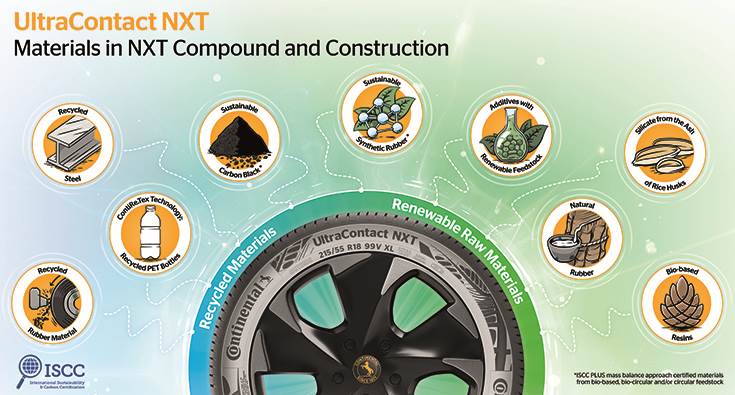Back in 2021, we looked at the move towards using sustainable materials in tyres, with major makers including Continental and Michelin aiming to radically clean up tyre production by 2050.
That essentially means replacing petroleum-based products used for the main ingredients (synthetic rubber and carbon black) with biomaterials and recycled carbon black, steel and plastic.
Unlikely substitutes include dandelions, PET from recycled bottles and rice husks – a by-product of the food industry normally good only for landfill.
Things have moved on: Continental recently said it would be the first to launch a tyre with a “high content” of sustainable materials on the mainstream market.

Its new Ultracontact NXT, which is suitable for both ICE cars and EVs, is up to 65% made from renewable or recycled materials. For any sceptics, 28% of the sustainable materials are certified through “mass balancing” in the International Sustainability and Carbon Certification (ISCC) process, which traces the path of sustainable materials as they move into a product.
Renewable materials add another 32% to the tally and the remaining 5% consists of recycled materials. The renewables include resins made using residue from the wood and paper industries, rather than petroleum-based raw material.
Silica plays an important role in tyre performance, influencing grip, rolling resistance and longevity. It has been used as a partial substitute for carbon black since the ’90s. Traditionally it’s made from sand.
There’s plenty of that in the world, but making silica from it is energy-intensive and involves temperatures of 1400deg C. In contrast, making silica from the ash of rice husks involves much less heat energy, in the region of 100deg C.
Recycled PET bottles are used to make polyester fibres, so although not renewable in the sense that the raw material is petroleum-based, it does make the process circular, preventing bottles being ploughed into landfill or incinerated. Between nine and 15 bottles go into each tyre, depending on size. The polyester fibres made from them is used internally in the carcass of the tyre.
Petroleum-based butadiene gas, usually derived from hydrocarbons and used to make synthetic rubber, is replaced by a bio-butadiene, which can be made from ethanol. Ethanol is easy to make (and has been for years) by fermenting biomass.
The all-important ingredient of tyres, carbon black, is usually made by burning oil or gas at high temperatures to make the granular powder. In this case, recycled carbon black from old tyres reduces the impact of that and is one of the things the ISCC certification covers.
The Ultracontact NXT will go on sale in Europe this month and refreshingly is not a niche product but aimed at mainstream cars. These include the Kia Niro, Tesla Model 3, Mercedes-Benz EQA, Skoda Octavia and Volkswagen Golf.
